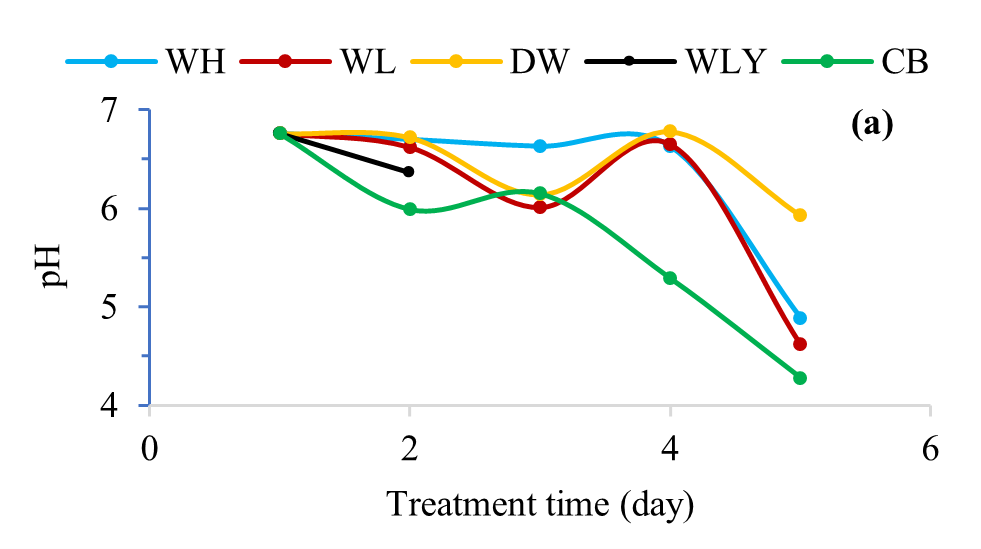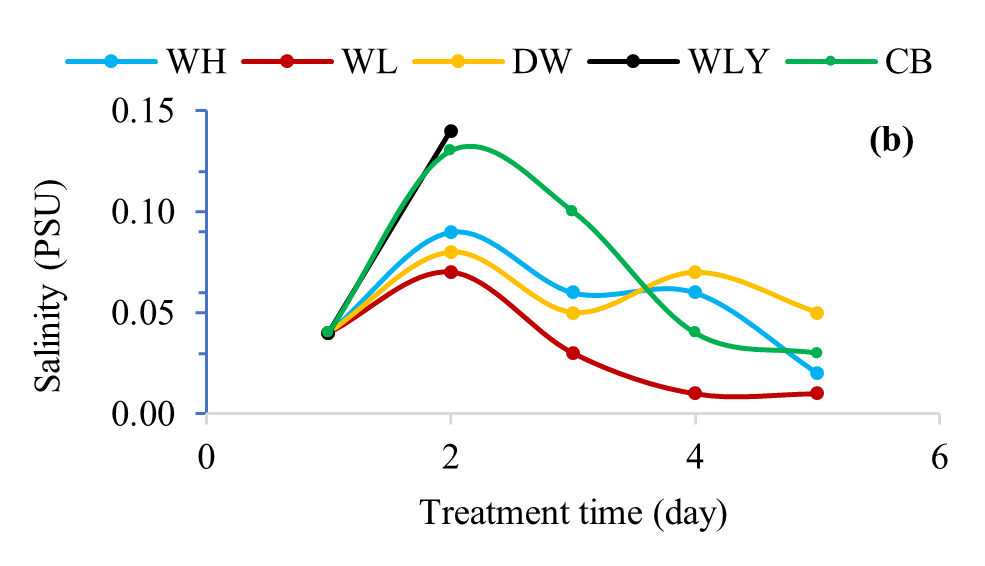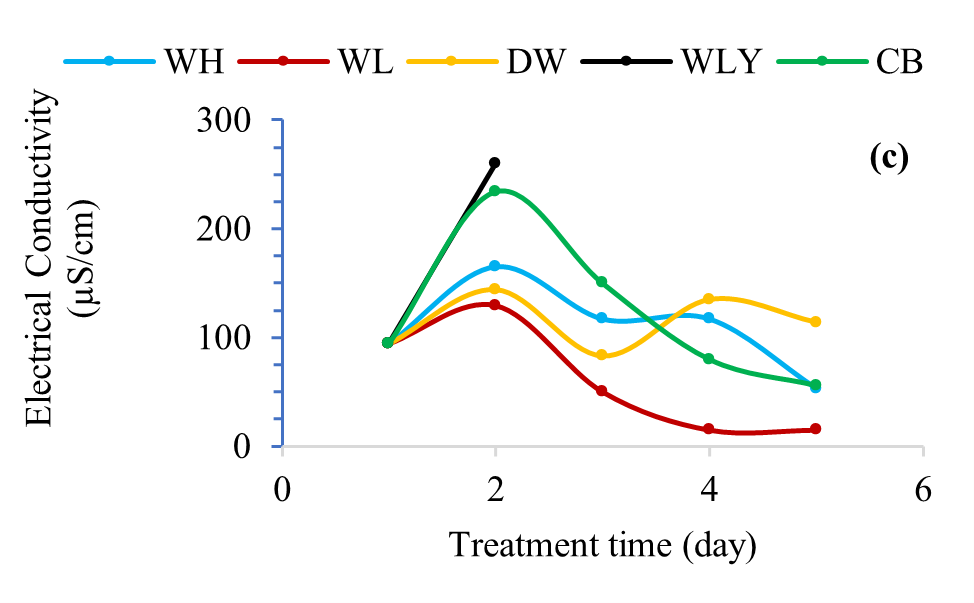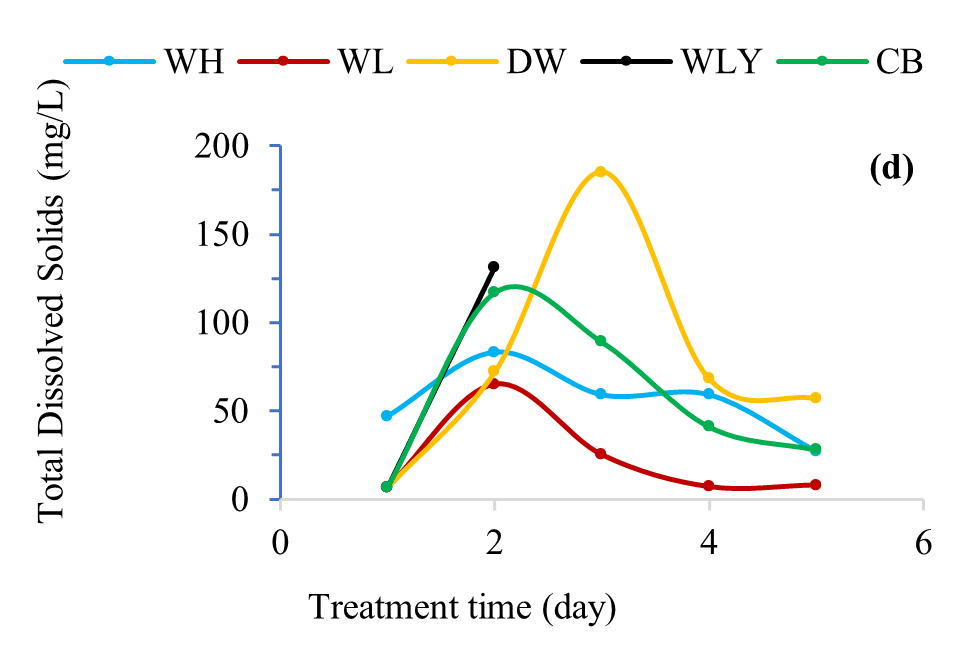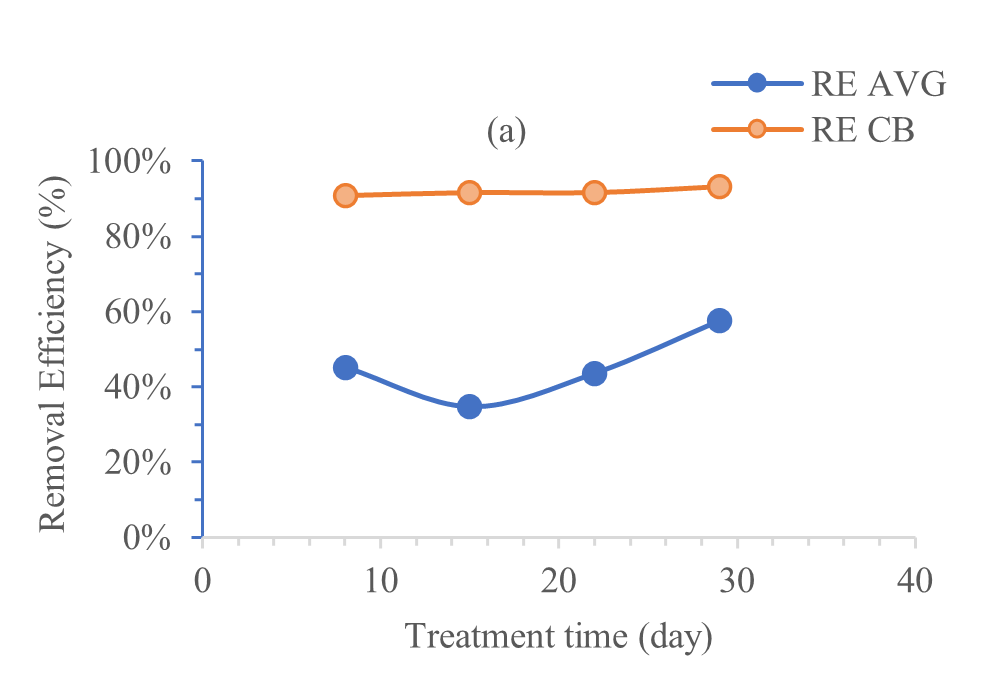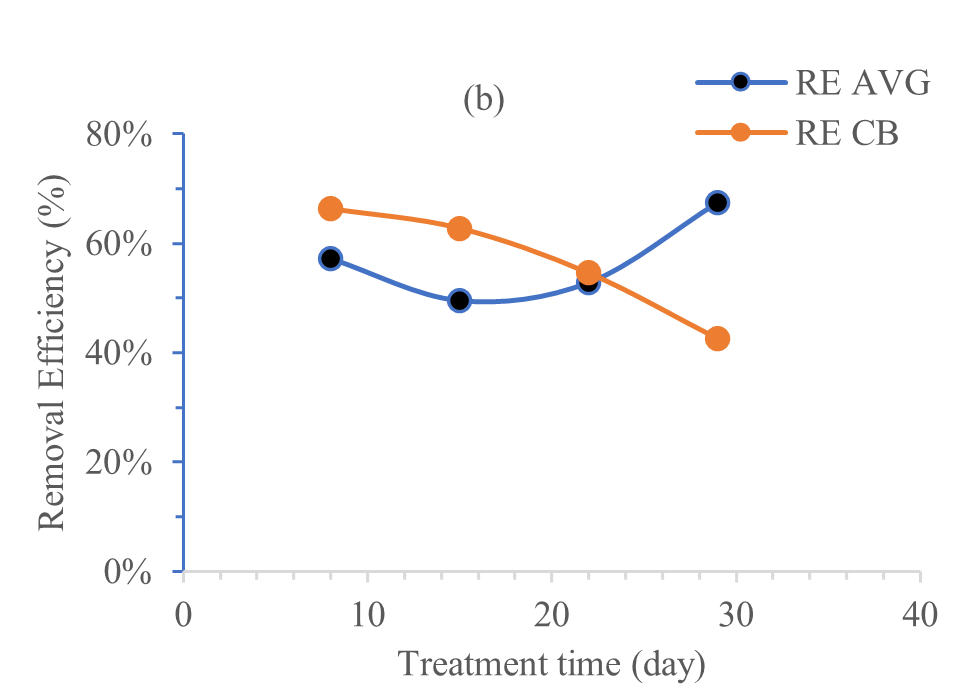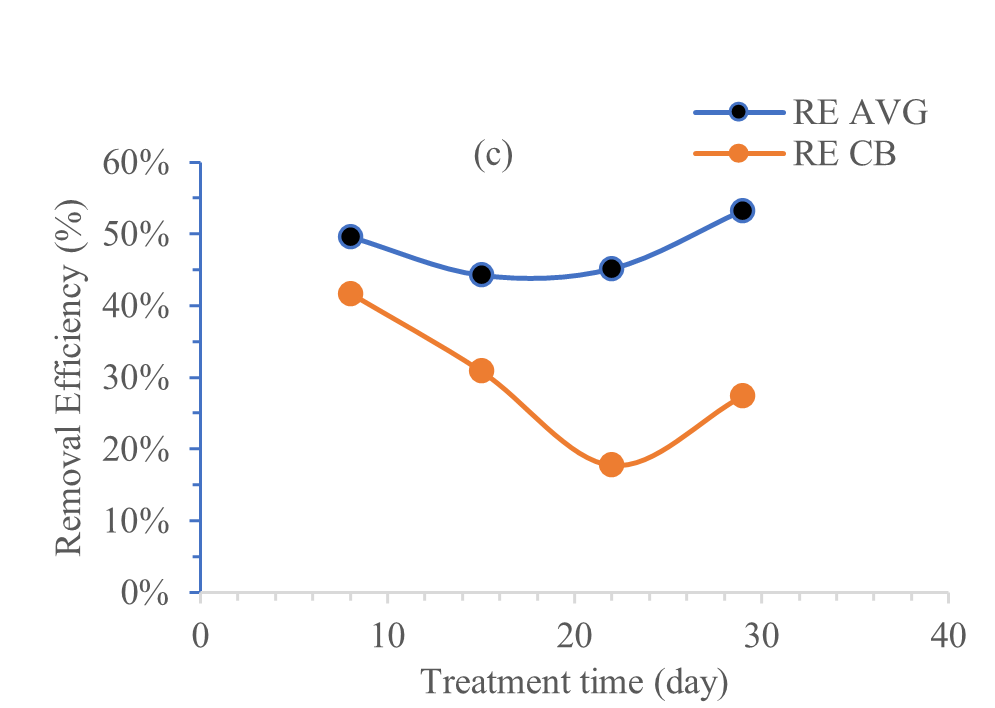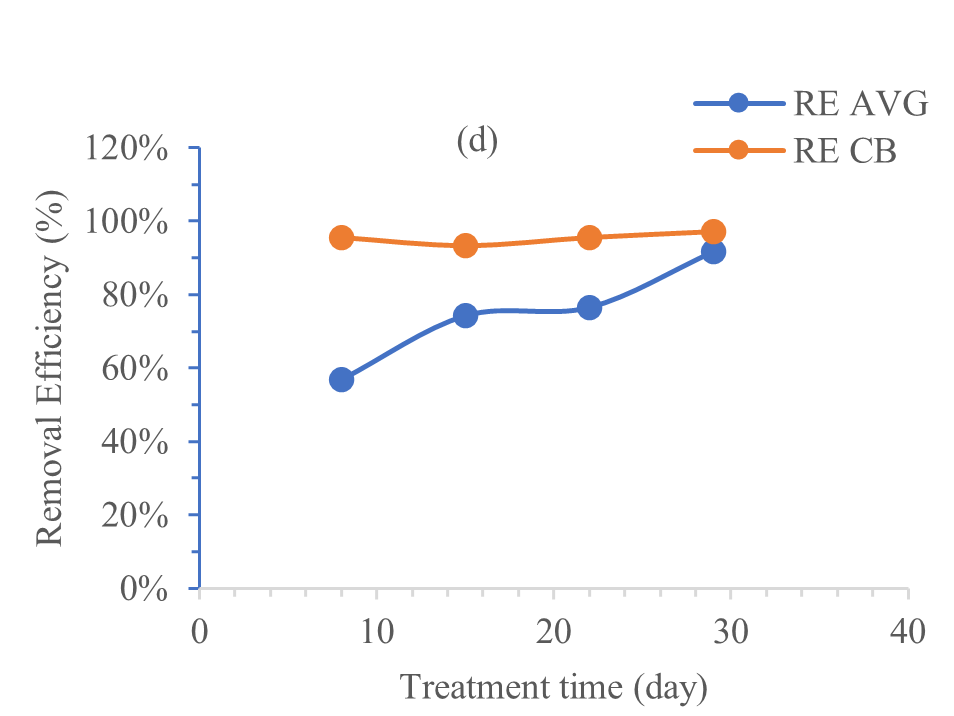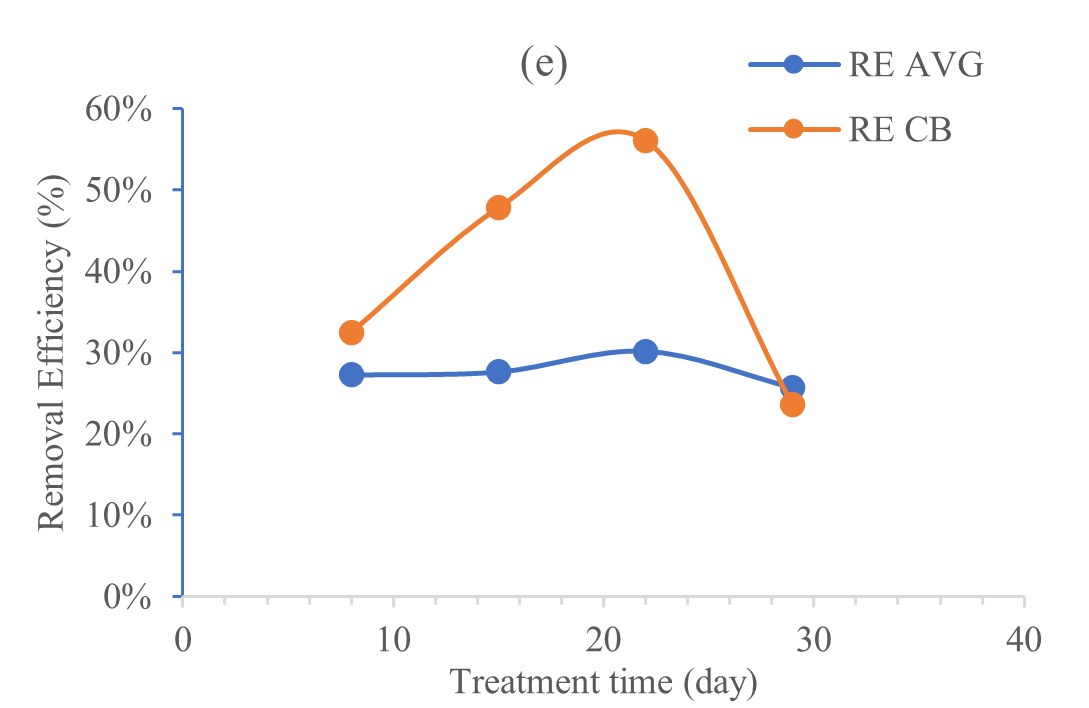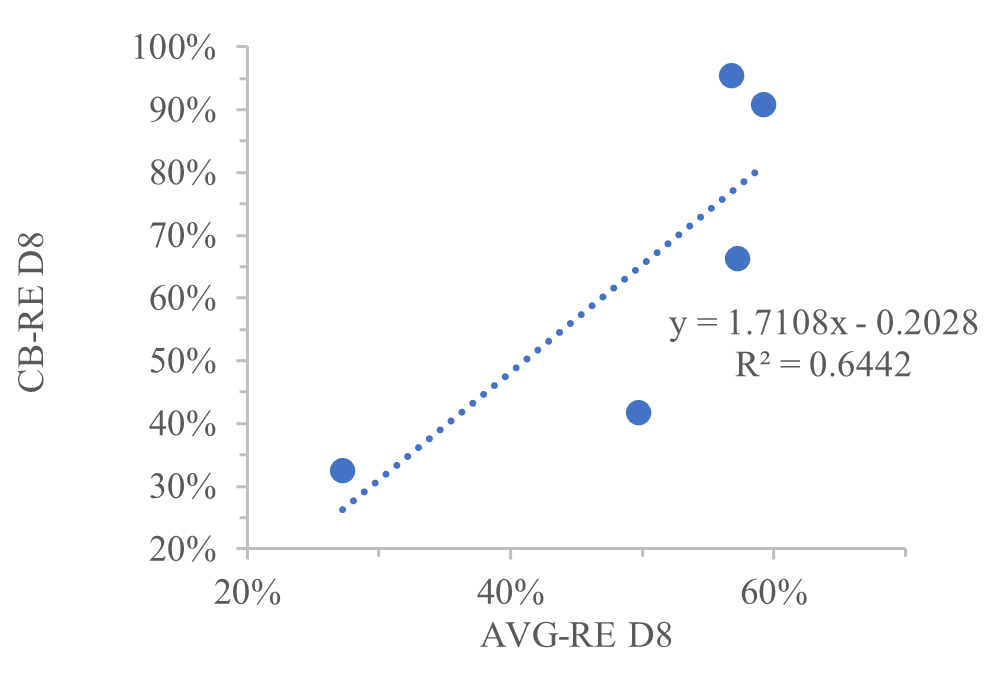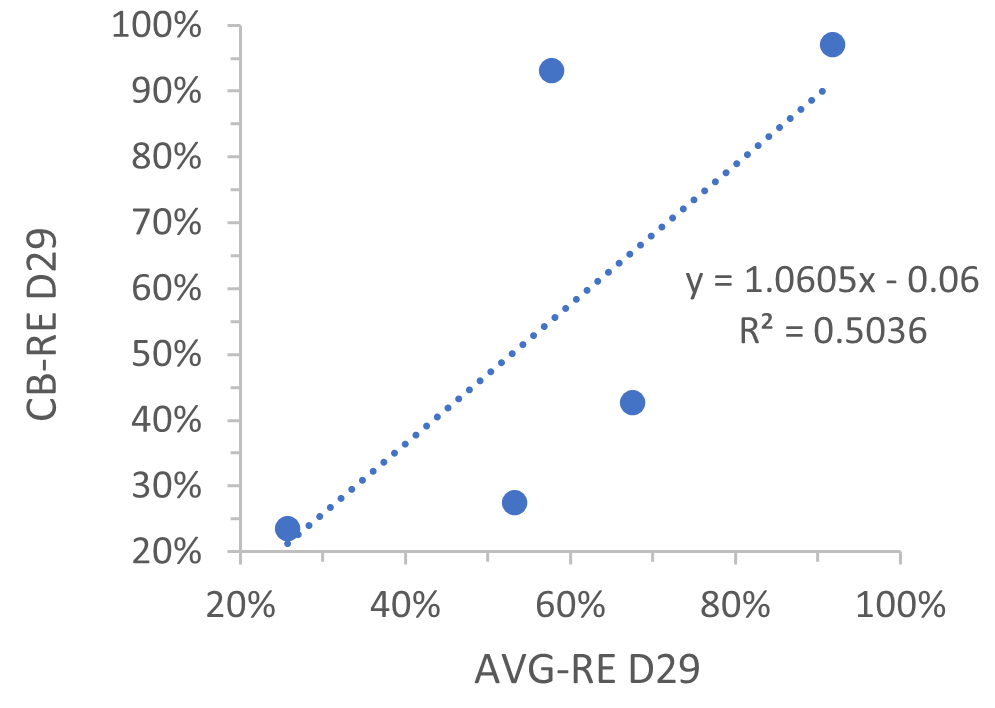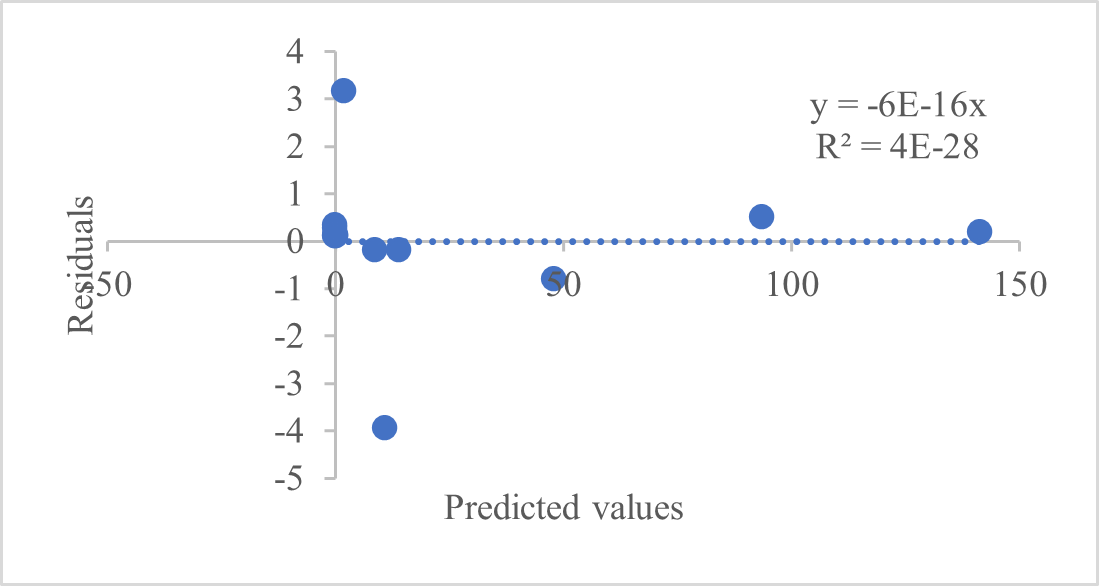Simultaneous Removal of Nutrients and Heavy Metals from Wastewater using Sole and Combined Water Macrophytes: Eichhornia crassipes, Lemna minor, Nymphaea, and Pistia stratiotes
- Adewale V. Ajiboye
- Adedeji A. Adelodun
- Josiah O. Babatola
- -618
- Sep 5, 2024
- Environmental Science
Simultaneous Removal of Nutrients and Heavy Metals from Wastewater using Sole and Combined Water Macrophytes: Eichhornia crassipes, Lemna minor, Nymphaea, and Pistia stratiotes
Adewale V. Ajiboye1*, Adedeji A. Adelodun2,3, Josiah O. Babatola1
1Department of Civil and Environmental Engineering, The Federal University of Technology Akure, Nigeria
2Department of Marine Science and Technology, The Federal University of Technology Akure, Nigeria
3Department of Chemistry, University of Copenhagen, Denmark
*Corresponding Author
DOI: https://doi.org/10.51244/IJRSI.2024.1108049
Received: 21 July 2024; Revised: 29 July 2024; Accepted: 02 August 2024; Published: 05 September 2024
ABSTRACT
We investigated the individual and combined (CB) performances of four aquatic plant species, Eichhornia crassipes (water hyacinth, WH), Lemna minor (duckweed, DW), Nymphaea (water lily, WLY), and Pistia stratiotes (water lettuce, WL) in removing selected nutrients (PO43-, NO3–, NH3) and heavy metals (Cd, Cr, Cu, Pb, Zn) from well water for a 30-day duration while monitoring changes in the physicochemical properties (pH, salinity, conductivity, total dissolved solid TDS). WLY could not thrive beyond the 10th day, while other plants lasted the whole test period. All macrophytes leached PO43- into the water, showing negative removal efficiencies as follows: WH>CB>WL>WLY>DW. Likewise, WL, DW, and CB leached NO3– into the solution, whereas WH showed no observable difference between the initial and final concentrations, and WLY reduced the initial concentration (13.56 mg/L) by 87.5%. All plants recorded significant NH3 removal except WLY, which raised the concentration from 4.88 to 5.04 mg/L. Individual and combined macrophyte set-ups significantly removed Cr, Cu, Cd, Pb, and Zn. WL was most effective in removing Cr, Cu, and Zn, achieving removal efficiency of 86.8%, 84.56%, and 62.42%, respectively. Also, CB had the highest removal efficiency of 93.08% for Cd and 97.09% for Pb. In conclusion, understanding the nature of water contaminants and physiochemical properties is essential for selecting the appropriate macrophytes, solely or combined, for optimum growth and effective phytoremediation.
Keywords: Water hyacinth; water lettuce; water lily; duckweed; heavy metals
INTRODUCTION
Water pollution, especially from excess nutrients and heavy metals, significantly threatens aquatic ecosystems and human health (Hama et al., 2023). For instance, the health risks caused by eutrophication can be reduced by rapidly eliminating nutrients and metals (Nguyen et al., 2023). Increasing population, urbanization, industrialization, and ill-management of natural water bodies contribute to the upsurge in the discharge of contaminants into various water bodies, thereby impairing their quality (Hoseinizadeh et al., 2011). The pollutants, especially heavy (trace or toxic) metals, could be refractory to biological treatments but could be made less toxic (Zhang et al., 2017; Jiang et al., 2018; Ansari et al., 2020). Generally, heavy metals are not biodegradable; their prolonged presence in soil or water in concentrations above the permissible limits for plants, animals, and humans could threaten the environment and ecosystem (Suman et al., 2018; Yan et al., 2020). Some metals are essential (Co, Cr, Cu, Fe, Mn, Mo, Ni, Zn), while others are nonessential (Cd, Pb, Hg, As). Essential heavy metals are required in trace quantities for various physiological and biochemical activities in plants and animals (Jomova et al., 2022). Still, if present in excess, they could become toxic, while nonessential heavy metals are toxic to plants and animals’ physiological, biological, and chemical processes (Martinez-Finley et al., 2012; Jomova et al., 2022). Since they can also be removed from contaminated media (Suman et al., 2018), various mechanical, physiochemical, and biological methods have been designed for this purpose (Yan et al., 2020). High cost, secondary pollution, complexity, and non-eco-friendliness, among others, are common demerits of the mechanical- and physicochemical-based methods (Saha et al., 2014; Sharma et al., 2018; Huynh et al., 2021). Besides being environmentally benign and sustainable, the biological-based method is also cost-effective for restoring water or environment quality, hence its wide adoption. It involves the use of microorganisms (bioremediation) to degrade and metabolize chemicals or plants (phytoremediation) to remove and contain the pollutants from the polluted media (Praveen & Nagalakshmi, 2022).
Phytoremediation is a plant-based technology for removing, containing, stabilizing, or reducing heavy metals (Adelodun et al., 2020) or organic pollutants (Garbisu & Alkorta, 2001; Adelodun et al., 2021) in the environment or contaminated media. While organic pollutants can be degraded and broken down into nontoxic and simple chemical forms, most inorganic pollutants are refractory, albeit they can be transformed or transported between media (Dickinson, 2017). Inorganic pollutants include acids, bases, chemical wastes, silt or fine-grained sediments, and heavy metals (Borah et al., 2020). This eco-friendly technology offers a promising solution for water contamination by taking advantage of nature’s innate ability of some plants to accumulate inorganic pollutants (Shmaefsky, 2020). Babu et al. (2021) critically reviewed the effectiveness of phytoremediation methods, the hyperaccumulator plants’ potentials, the biotechnological approach for heavy metals decontamination, and recently developed innovations, improvements, and prospects of improving phytoremediation. During this process, plants with hyperaccumulator body parts capable of tolerating toxic metals in high quantities detoxify the toxic metal-laden environments (Nedjimi, 2021).
Phytostabilization, phytovolatization, phytodegradation, rhizofiltration, phytostimulation, phytoextraction, rhizodegradation, and phytodesalination are various phytoremediation techniques for soil or water decontamination (Yan, A. et al., 2020; Nedjimi, 2021). Selecting appropriate plant species is crucial for maximizing the efficiency of phytoremediation. The factors considered include biomass production rate and quantity, ease of cultivation, and photosynthetic activities (Kafle et al., 2022). Because of the diverse contaminants and macrophytes, the environment, climatic conditions, and the contaminant’s chemistry are essential to choosing a phytoremediator (Chirakkara & Reddy, 2015). Over 400 plant species with different metal accumulation mechanisms have been studied and identified as potential hyperaccumulators for soil and water pollutants (Lone et al., 2008; Sabreena et al., 2022). The role of some aquatic plants in water treatment cannot be overemphasized. In their natural habitat, they stabilize the surface beds, assimilate pollutants, and facilitate several chemical and biochemical reactions that result in environmental purification (Sun et al., 2013).
Of the several aquatic plant species used to remove heavy metals are duckweed (Lemna minor) (Syeda et al., 2016; Ubuza et al., 2020), water hyacinth (Eichhornia crassipes) (Aisien et al., 2010; Abdelaal et al., 2021), water lettuce (Pistia stratiotes) (Kouamé et al., 2016; Amalia et al., 2019) and Water lily (Nymphaea) (Galadima et al., 2015; Gemeda et al., 2019).
Numerous studies have shown that these four aquatic plants can efficiently remove nutrients and heavy metals from polluted media (Mukherjee et al., 2015; Gemeda et al., 2019; Kumar and Deswal, 2020; Omokheyeke and Alame, 2021). Still, their behaviors in non- or less polluted water (such as well water) have not been adequately harnessed. Well water, a type of groundwater assessed through a hole drilled to reach the water table (aquifer) beneath the ground surface, has become increasingly explored due to population growth (Idowu et al., 2011). Approximately 38% of the US population relies on groundwater (Maupin, 2018), while the dependency in Asia is 79% (Carrard et al., 2019) and 70-90% in Africa, including Nigeria (Grönwall and Danert, 2020). Groundwater is usually a natural source of potable water, but if not adequately protected or managed, it can be easily polluted. Therefore, this study aimed to compare the individual and combined capabilities of E. Crassipes, L. Minor, Nymphaea, and P. Stratiotes to remediate heavy metal- and nutrient-laden well water.
MATERIALS AND METHOD
A. Sampling
At various locations in the same water body, water hyacinth (latitude 6.353677 & longitude 4.808566), water lettuce (lat. 6.353379 & lon. 4.809391), water lily (latitude 6.354416 & longitude 4.803633), and duckweed (lat. 6.352702 & lon. 4.806991) were collected from Igbokoda in Ilaje Local Government Area of Ondo State, Nigeria. The plants collected with the underlay water in precleaned plastic bowls was transported to the experiment location. Well water was collected from a well in one of the halls of residence within the Federal University of Technology Akure premises in copiously rinsed plastic gallons. The plant samples were rinsed thoroughly with distilled water to remove stones, specks of dust, and other foreign bodies before introducing them to the well water the same day.
B. Experiment Set-up
The macrophytes were each weighed and immersed in aliquots of well water for an individual macrophyte system. Prototype of water hyacinth (WH) weighing 300 g was placed in 6 L of well water, 100 g of water lettuce (WL) placed in 2 L, 150 g of water lily (WLY) placed in 3 L, and 50 g of duckweed (DW) in 1 L. The combined (CB) system had in 7 L of well water 150, 50, 100, and 50 g of WH, WL, WLY, and DW, respectively. The experiment lasted 30 days for WH, WL, DW, and CB, but 10 days for WLY, because WLY leaves started wilting on day 8.
The physicochemical parameters, along with the nutrient and heavy metal contents of the set-ups, were taken on the second day of the experiment as day 1. The sampling was continued weekly until day 29, i.e., the 30th day of setting up. The morphological changes of the macrophytes were observed to inform on the overall performance, adaptability, and survival outside their natural habitat. Nutrient uptake, bioaccumulation, and removal efficiency were estimated based on the changes in the physicochemical parameters and metal uptake.
C. Data Collection and Analysis
At the experimental site, a well-calibrated, handheld multiparameter water analyzer (Hannah 9828) measured the physicochemical properties of the water sample, including pH, salinity, electrical conductivity, oxidative-reduction potential (ORP), and total dissolved solids (TDS). Water samples taken weekly from the set-ups were analyzed for nitrate (NO3–), phosphate (PO43-), and ammonia (NH3) using sodium salicylate, ascorbic acid, and phenate spectrophotometric methods, respectively (USEPA 600/4-79-020). Jenway 6400 ultraviolet/visible spectrophotometer measured the respective absorbance wavelengths 420, 880, and 640 nm for NO3–, PO43-, and NH3, respectively.
An atomic absorption spectrophotometer (AAS model 211 VGP buck scientific) measured the heavy metal content (i.e., Pb, Cd, Cr, Cu, and Zn) of the samples obtained from the sampling site (status quo) in the well water during and after the phytoremediation experiment. Then, the removal efficiency (RE) of the macrophytes was evaluated, indicating the uptake of the selected minerals and heavy metals as follows:
D. Quality Control/Quality Assurance
The water samples were analyzed in duplicates, and the average values were the results. The analysis was repeated where the duplicate measurements were widely dissimilar. Analytical-grade reagents were used in this experiment. Standard analytical methods were adopted, and certified reference materials validated the accuracy.
RESULTS AND DISCUSSION
A. Physical Observations and Biomass Production
The increase in plants’ height, mass, and size as they develop and reproduce is called plant growth (Huynh et al., 2021). WH, WL, and DW survived four weeks in the water sample, while WLY could not thrive beyond ten days. WH, WL, and DW increased in stem length, leaf width, and plant population in individual and combined set-ups. The biomass production rate of DW and WL was higher, with the plant population almost doubling by day 15. The available nutrients in the water encouraged the initial weight gain and vegetative reproduction before the plants began to strive for survival in the nutrient-depleted environment. Therefore, nutrient balance must be attained for optimal plant growth and survival microbial activities for effective phytoremediation.
Nutrient amendments improve the efficiency and effectiveness of the plants for phytoremediation (Gillespie et al., 2020; Samudro and Mangkoedihardjo, 2020). Due to nutrient depletion by the third week, necrosis occurred in some leaves. Elsewhere, Edaigbini et al. (2015) reported the browning of WH and WL leaves in the first two weeks of remediating polluted water before eventually turning necrotic and wilting. Similarly, Mukherjee et al. (2015) and Kumar and Deswal (2020) reported similar observations using salvinia molesta, water hyacinth, water lettuce, and duckweed to treat rice mill wastewater.
B. Nutrient Uptake
Each plant species exhibited varying nutrient and heavy metal uptake capabilities. In some instances, nutrient leaching from the plants into the water was observed. WH, WL, and DW demonstrated significant removal efficiencies for NH3 in the order DW (64.41%) > WH (57.63%) > WL (55.93%). All the plants released NH3 into the water in the first 15 days, with DW leaching the most significantly. NH3 removal was recorded on day 22 for the three plants that thrived beyond the 10th day. The increase in the initial NH3 concentration in the water for each treatment in the first 15 days could be due to the decomposition of fallen leaves in the water (Wu et al., 2017; Kumar & Deswal, 2020; Adelodun et al., 2021). Also, organic matter rich in nitrogen could contribute to ammonia synthesis. NH3 is a vital water pollutant; it is relatively toxic for plants, retarding their reproduction and growth, and, in high concentrations, could cause death. However, NH3 can be converted to nitrite and nitrate by bacteria for plant use (Kiraly et al., 2013). Furthermore, pH is one of the factors that influence ammonia toxicity. A pH increase converts NH4+ to NH3, with increased toxicity (Ting et al., 2018). The toxicity also increased with temperature.
The WLY achieved 87.5% NO3– RE by the end of week 1. Simultaneously, DW had a 25% RE but increased to 33.75% by the end of week 2. These values resulted in a final NO3– concentration of 57.63 mg/L (i.e., 32.5% increase over the initial concentration). Gradually, the initial NO3– leached by WH was removed until no difference was observed between the initial and final concentrations. With WL, the final NO3– concentration was higher than the initial, indicating leaching.
All the plants released PO43- into the water in the orders WH≥WLY>DW>WL and WH>WL>DW by the end of weeks 1 and 4, respectively. The increased PO43- content could be attributed to the decomposed fallen leaves from the plant (Kumar & Deswal, 2020). In another study (Wu et al., 2017), WH and two other macrophytes’ decomposition characteristics were evaluated in a constructed wetland. The decomposition of WH released more phosphorous into the water than the other two plants and increased the final total phosphorous concentration. It is worth noting that while the macrophytes could not survive due to nutrient depletion, the increased phosphate level in the system would encourage algal growth and low dissolved oxygen in the system, leading to eutrophication. Kwon et al. (2021) opined that plant growth stage, plant type, or plant sampling location contribute to the high fluctuations in the concentration of nitrogen and phosphorous during plant growth in hydroponic systems.
C. Heavy Metal Removal Efficiency
Since WLY could not thrive beyond the 10th day, we assessed the changes (Table 1) in all the parameters by the end of week 1 (day 8). DW exhibited the highest RE against Cd (92.31%) and Pb (93.18%), while WH evinced the highest Cr (69.54%) and Zn (59.25%) removal on day 8. WL recorded the highest RE (77.53%) for Cu by day 8; however, by day 29 (Table 2), WH recorded 68.78% and 14.65% for Cr and Zn, respectively, suggesting metal leaching into the water. On the other hand, WL increased Cr and Zn RE from 55.58% and 51.59% on day 8 to 86.80% and 62.42%, respectively, on day 29. However, at the end of week 1, WL accumulated more Pb with a 77.27% RE than WH (40.91%). These results suggest that WL (Pistia stratiotes) has a higher Pb affinity than WH (Eichhornia crassipes), affirming a conclusion from a previous report (Tabinda et al., 2019).
These results affirm the viability of the selected macrophytes for remediating polluted waters and soils. On day 29, the CB set-up recorded a 93.08% Cd removal, the highest on day 29, followed by WL with 90.00%. CB and DW removed Pb efficiently up to 97.09 and 95.64%, respectively, while WL phytosorbed Cr, Cu, and Zn with 86.80%, 84.56%, and 62.42% efficiencies, respectively. However, all the plants individually and combined removed Pb significantly, with the WL recording the lowest RE of 88.64%. Our findings about Pb removal by WH and WL align with those of a similar study (Eid et al., 2020). In another study, Kouamé et al. (2016) reported significant removal (>50%) of Cr, Cu, Pb, and Zn from wastewater while adducing the roots of WH and WL to remove heavy metals more effectively than the leaves. However, in the current study, DW first removed approximately 3.82% of Zn from the water sample by the second day of exposure but further leached it metal until the trend was reversed after day 22. There was no change between the initial and final concentrations of Zn in the DW set-up, which was attributed to the low Zn concentration. Notably, the removal efficiency of WH for Cr, Cu, and Zn lowered with their concentration. Huynh et al. (2021) also reported a gradual decrease in WH’s efficiency in removing Cd, Zn, Cu, As, and Pb with a reduction of the metals’ concentrations. Also, WH exhibited similar removal efficacy towards Cr to that observed by Buta et al. (2023), where 90%-94% removal efficiency was recorded within one week. However, the RE for Cr was less in this study than reported elsewhere (Buta et al., 2023).
Table 1: Initial and day 8 values/concentrations of parameters
| Values and Concentrations on Day 8 | ||||||
| Parameters | Initial Value/Conc. | 1WH | 2WL | 3DW | 4WLY | 5CB |
| pH | 6.76 | 6.70 | 6.62 | 6.72 | 6.36 | 5.99 |
| Salinity (PSU) | 0.04 | 0.09 | 0.07 | 0.08 | 0.14 | 0.13 |
| Conductivity (µS/cm) | 94.00 | 165.00 | 129.00 | 144.00 | 260.00 | 234.00 |
| TDS (mg/l) | 47.00 | 83.00 | 65.00 | 72.00 | 131.00 | 117.00 |
| 6ORP | 141 | 120 | 138 | 129 | 111 | 87.6 |
| PO43- (mg/l) | 8.40 | 67.2 | 15.8 | 13.3 | 67.2 | 42.0 |
| NO3– (mg/l) | 13.6 | 8.64 | 89.8 | 10.2 | 1.69 | 39.0 |
| NH3 (mg/l) | 4.88 | 5.13 | 5.50 | 5.04 | 5.04 | 4.79 |
| Cd (mg/l) | 0.01 | 0.01 | 0.01 | 0.00 | 0.01 | 0.00 |
| Cr (mg/l) | 0.20 | 0.06 | 0.09 | 0.12 | 0.07 | 0.07 |
| Cu (mg/l) | 0.13 | 0.07 | 0.03 | 0.09 | 0.08 | 0.08 |
| Pb (mg/l) | 0.02 | 0.01 | 0.01 | 0.00 | 0.02 | 0.00 |
| Zn (mg/l) | 0.08 | 0.03 | 0.04 | 0.09 | 0.07 | 0.05 |
1water hyacinth; 2water lettuce, 3water lily, 4duckweed, 5combined microphytes, 6oxidation-reduction potential
Table 2: Initial and day 29 values/concentrations of parameters
| Values and Concentrations on Day 29 | |||||
| Parameters | Initial Value/Conc. | WH | WL | DW | CB |
| pH | 6.76 | 4.89 | 4.62 | 5.93 | 4.28 |
| Salinity (PSU) | 0.04 | 0.02 | 0.01 | 0.05 | 0.03 |
| Conductivity (µS/cm) | 94.00 | 53.00 | 15.00 | 114.00 | 56.00 |
| TDS (mg/l) | 47.00 | 27.00 | 8.00 | 57.00 | 28.00 |
| ORP | 141 | 145.1 | 163 | 112 | 186 |
| PO43- (mg/l) | 8.40 | 126 | 84.0 | 58.8 | 118 |
| NO3– (mg/l) | 13.6 | 13.6 | 50.9 | 57.6 | 93.2 |
| NH3 (mg/l) | 4.88 | 2.07 | 2.15 | 1.74 | 2.65 |
| Cd (mg/l) | 0.01 | 0.00 | 0.01 | 0.00 | 0.00 |
| Cr (mg/l) | 0.20 | 0.06 | 0.03 | 0.10 | 0.11 |
| Cu (mg/l) | 0.13 | 0.08 | 0.02 | 0.08 | 0.09 |
| Pb (mg/l) | 0.02 | 0.00 | 0.00 | 0.00 | 0.00 |
| Zn (mg/l) | 0.08 | 0.07 | 0.03 | 0.08 | 0.06 |
D. Effect of the Treatment on pH, Salinity, Conductivity, and Total Dissolved Solids
Changes in the pH, salinity, conductivity, and total dissolved solids that occurred during the phytoremediation are illustrated in Figure 1. Also, Tables 1 and 2 showed the values recorded for these parameters for days 8 and 29 respectively. By day 8, WH, WL, DW, and WLY had lowered the pH from 6.76 to 6.7, 6.62, 6.72, and 6.36, respectively. WH, WL, and DW further decreased the pH of their set-ups to 4.89, 4.62, and 5.93, respectively by day 29, making the water more acidic. Since the plants’ survival could be halted at pH <5.5, the plants wilted eventually. However, nutrient adjustment can make plants grow in a wide pH range (4.0–8.0) without affecting the root and shoot (Gillespie et al., 2020). Overall, CB reduced the pH than the average individual performance of all the plants. In contrast, Kumar and Deswal (2020) reported an increase in pH attributed to the photosynthesis activities of the plants and the presence of periphyton.
All the plants, except DW, exhibited a salinity reduction at the end of the experiment. However, an increase in salinity was recorded by the end of week one in all the set-ups because the plants released their saline content into the water. The initial salinity and those recorded during and after the experiment were lesser than the plants’ salinity tolerance limits of 2.5-9.0 ppt (Bick et al., 2020; Vázquez et al., 2021). Several authors, (Bick et al., 2020; Kumar et al., 2021; Vázquez et al., 2021), reported that plants exposed to salinity higher than their tolerance limits experienced high-stress levels, became necrotic, and died within a few days. Hence, salinity concentration did not threaten the plant’s growth in this experiment.
The correlation between salinity and electrical conductivity (EC) was evident in the performance of both individual and combined plant systems. EC is a measure of total dissolved salts in hydroponic nutrient solutions (Meselmani, 2021); the higher the EC, the higher the salinity. After week 1, EC increased significantly. By the end of week 4, all systems evinced reduced EC except for DW. The same trend was observed in the plant’s behavior towards salinity during and after the phytoremediation.
Figure 1: Variation of (a) pH, (b) salinity, (c) electrical conductivity, and (d) total dissolved solids in all set-ups over the phytoremediation period
The salt deposition from the plants into the well water, evident in the increase in salinity, could be ascribed to the increase in total dissolved solids (TDS) by Day 8. A significant TDS removal was observed by Day 29 in all the set-ups except for DW. WL recorded the highest TDS removal of up to 83%, followed by WH (42.6%) and CB (40.4%). Abinaya et al. (2018) reported that WH and WL significantly removed TDS during the second-stage phytoremediation of an RO-Brine solution. However, the RE of WH was higher than that of WL, contrary to our study’s finding. Similarly, Prasad et al. (2021) reported substantial TDS reduction using WH grown grey water phytoremediation. Another study reported that WL removed 70% of TDS compared to 15% recorded for DW (Nayanathara and Bindu, 2017).
E. Comparison of Individual Plant Heavy Metal Removal against Combined Efficiency
Comparing the average individual plant performance for heavy metal removal against the combined efficiencies of the macrophytes (CB) showed that CB was more effective in removing heavy metals in a short period (day 8). Average heavy metals removal efficiencies of 47.22 and 65.40% was recorded for the sole and CB macrophytes respectively. At the end of the experiment, CB had the highest removal efficiencies for Cd and Pb than the individual plant, following the trend CB>DW>WL>WH, WL>WH>DW>CB, WL>WH>DW>CB, CB>DW>WH>WL, and WL>CB>WH>DW for Cd, Cr, Cu, Pb, and Zn respectively. Figure 2 shows the relative average individual plant removal of the heavy metals versus the CB experiment.
Having evaluated the effects of combined macrophytes to phytoremediate heavy metals, it was pertinent to investigate the relationship between the REs of individual water plants and the combined ones (CB). The relationship between the RE of the CB and average RE for individual plants evinced positive coefficients of correlation (R2). At p=0.05, R2 of 0.6442 and 0.5036 were deduced for the 8th and 29th days respectively, as shown in Figure 3.
Figure 2: Average removal efficiencies of individual versus combined (CB) species for (a) Cd, (b) Cr, (c) Cu, (d) Pb, and (e) Zn over the phytoremediation period of four weeks
Figure 3: Relationship between the heavy metals RE of the combined plants (CB) and average RE of the individual plant for (a) Day 8 and (b) Day 29 of the phytoremediation period
Indicatively, the selected plants can be used to remediate heavy metals polluted media, while combining two, three, or more plants during phytoremediation would also perform even better. Samudro and Mangkoedihardjo (2020) reviewed using mixed plants for phytoremediation, noting the required essential nutritional conditions to aid plant growth while ensuring effective phytoremediation. Furthermore, the selected plants must have an efficient synergy in removing contaminants in the polluted media. Aside from studying the individual performance of the plants, Davis et al. (2023) assessed the bioconcentration and translocation factors of individual plants in the combined experiment. The authors used two groups of five plant species to remediate Pb and Cd from two different soil samples, with WH present in each plant species group and WH efficiently both metals from the soil. Likewise, up to 74% RE for Cr was recorded in the preliminary assessment conducted by Mangkoedihardjo and Utomo (2018) using mixed plants to remediate Cr-contaminated soil.
Figure 1 (b and c) shows our results agree with the relationship between salinity and conductivity. Specifically, at the end of the experiment, conductivity decreased for all the set-ups except DW, which increased conductivity, indicating that more salts were dissolved in the solution. High conductivity results in high and low Cd and Zn phytoremoval, respectively (Salimi et al., 2013; Mohammad et al., 2023). Our results also show that high conductivity, such as in DW, was accompanied by a higher Cd RE. In contrast, there was no significant change with Zn throughout the experiment. However, there was a noticeable interaction between the DW and Zn, with Zn leaching from the plant into the water by day 8. Understanding the behavior of these plants is critical for their selection and effectiveness for wastewater treatment. Organic and inorganic concentrations in the wastewater, treatment conditions, and the duration of the treatment are relevant factors to consider for effective phytoremediation (Nguyen et al., 2023) in addition to the plant sampling and growth stage earlier stated in this study.
We correlated the physical and chemical parameters against one another to determine their interrelationship and associated influence on the remediation process. The correlation coefficient (R2) values were determined at p = 0.05 and presented in Table 3. Similarly, the linear regression was carried out to evaluate the strength of the correlation between the plant species and the final values of all the parameters. The R-squared shows that 99.9% of the variation in the initial values of parameters was attributable to the final parameters’ values for each plant species and the co-cultured (Table 4). The relationship between parameters’ initial and final values and plant species is statistically significant. The residual plot (Figure 4) of the predicted initial values of the parameters in the water and the residuals showed linearity and a strong correlation between the final values of water parameters and the predicted values.
Table 3: Coefficient of correlation (R2) between the water-evaluated parameters and plant culture
| pH | Salinity | EC | TDS | ORP | PO43- | NO3– | NH3 | Cd | Cr | Cu | Pb | Zn | |
| pH | 1 | ||||||||||||
| Salinity | 0.69 | 1 | |||||||||||
| EC | 0.77 | 0.98 | 1 | ||||||||||
| TDS | 0.77 | 0.98 | 1.00 | 1 | |||||||||
| ORP | -0.71 | -0.61 | -0.71 | -0.72 | 1 | ||||||||
| PO43- | -0.91 | -0.56 | -0.57 | -0.57 | 0.50 | 1 | |||||||
| NO3– | -0.57 | 0.06 | -0.13 | -0.13 | 0.48 | 0.37 | 1 | ||||||
| NH3 | 0.63 | 0.25 | 0.26 | 0.26 | 0.08 | -0.70 | -0.39 | 1 | |||||
| Cd | 0.74 | 0.12 | 0.19 | 0.19 | -0.18 | -0.80 | -0.68 | 0.89 | 1 | ||||
| Cr | 0.75 | 0.72 | 0.71 | 0.71 | -0.19 | -0.70 | -0.18 | 0.83 | 0.62 | 1 | |||
| Cu | 0.63 | 0.72 | 0.75 | 0.74 | -0.20 | -0.46 | -0.20 | 0.69 | 0.43 | 0.94 | 1 | ||
| Pb | 0.79 | 0.29 | 0.35 | 0.35 | -0.17 | -0.82 | -0.58 | 0.96 | 0.97 | 0.79 | 0.63 | 1 | |
| Zn | 0.68 | 0.86 | 0.92 | 0.92 | -0.58 | -0.39 | -0.28 | 0.34 | 0.22 | 0.74 | 0.87 | 0.39 | 1 |
Table 4: Regression analysis between the initial and final values of evaluated water parameters
| Regression Statistics | |
| Multiple R | 0.999 |
| R Square | 0.999 |
| Adjusted R Square | 0.998 |
| Standard Error | 1.829 |
| Observations | 13 |
Figure 4: Regression residual plot between the initial and final values of parameters for all the experimental set-ups
CONCLUSIONS AND RECOMMENDATIONS
Nutrients and heavy metals uptake were evaluated in this study about the remediation potential of water hyacinth (WH), water lettuce (WL), water lily (WLY), and duckweed (DW) planted individually or combined (CB) in well water. The plants recorded significant interactions with NH3, NO3–, and PO43- concentrations and the trace metals. While concentrations of NH3 and NO3– were reduced at the end of the experiment, the level of PO43- was increased due to the continuous interaction of the decomposition of dead roots, tissues, and leaves of the plants. We deduced that all the plants uptake the selected heavy metals more effectively, with the CB removing Cd and Pb more effectively than the individual plants. Furthermore, we observed that the removal efficiency of WH for Cr, Cu, and Zn reduces with the decrease in their concentrations in the water. Therefore, we suggest adequate monitoring of the phytoremediation system to immediately remove dead roots, shoots, and leaves of plants from the system to discourage algae growth and avoid eutrophication and further degradation of the water quality. Similarly, a nutrient balance must be attained by amendment for plant growth and survival during the remediation period for effectiveness. More studies should, therefore, be conducted on the relationship between the remediation characteristics of the plants in both highly and less contaminated media. We therefore recommend that WH, WL, WLY, and DW be used as individual phytoremediators or a combination of two or more plants for phytoremediation of contaminated water.
ACKNOWLEDGEMTS
The authors acknowledge the assistance and support of Mrs Tolu Ogunsuyi and Mr. Sunday Ojogbon of the Chemical Oceanography Lab, Department of Marine Science and Technology, The Federal University of Technology, Akure, Nigeria.
DECLARATIONS
Conflict of Competing Interests: The authors declare no conflicts of interest.
Compliance with Ethical Standards: Not applicable.
Consent to Participate: This article does not involve any human subjects.
Funding: This research was self-funded and did not receive any external funding.
Availability of data and materials: Authors will make the raw data available upon request to the Corresponding author.
REFERENCES
- Abdelaal, M., Mashaly, I.A., Srour, D.S., Dakhil, M.A., El-Liethy, M.A., El-Keblawy, A., El-Barougy, R.F., Halmy, M.W.A., and El-Sherbeny, G.A. (2021). Phytoremediation Perspectives of Seven Aquatic Macrophytes for Removal of Heavy Metals from Polluted Drains in the Nile Delta of Egypt. Biology, 10: 560. https://doi.org/10.3390/biology10060560
- Abinaya, S., Saraswathi, R., Rajamohan, S., and Mohammed, S. (2018). Phyto-remediation of total dissolved solids (TDS) by Eichhornia Crassipes, Pistia Stratiotes and Chrysopogon Zizanioides from second stage RO-Brine solution. Research Journal of Chemistry and Environment, 22(5): 36-41.
- Adelodun, A.A., Olajire, T., Afolabi, N.O., Akinwumiju, A.S., Akinbobola, E., and Hassan, O.U. (2021). Phytoremediation potentials of Eichhorniacrassipes for nutrients and organic pollutants from textile wastewater. International Journal of Phytoremediation. Retrieved from https://doi.org/10.1080/15226514.2021.1895719.
- Adelodun, A.A., Afolabi, N.O., Chauque, E.F.C., Akinwumiju, A.S. (2020). The potentials of Eichhormia crassipes for Pb, Cu, and Fe removal from polluted waters. SN Applied Science 2, 1646. https://doi.org/10.1007/s42452-020-03392-9
- Aisien, F. A., Faleye, O. & Aisien, T. E. (2010). Phytoremediation of Heavy Metals in Aqueous Solutions. Leonardo Journal of Sciences, Vol. 17, pp. 37-46. ISSN 1583-0233.
- Amalia, A. A., Rahardja, B. S., and Triastuti, R. J. (2019). The Use of Water Lettuce (Pistia stratiotesas) as Phytoremediator for Concentration and Deposits of Heavy Metal Lead (Pb) Tilapia (Oreochromis niloticus) Gills. IOP Conf. Series: Earth and Environmental Science, 236, 012055.
- Ansari, A.A, Naeem, M., Gill, S.S., and AlZuaibr, F.M. (2020). Phytoremediation of Contaminated Waters: An Eco-friendly Technology Based on Aquatic Macrophytes Application. Egyptian Journal of Aquatic Research, 46, pp. 371-376
- Babu, S.M.O.F., Hossain, M.B., Rahman, M.S., Rahman, M., Ahmed, A.S.S., Hasan, M.M., Rakib, A., Emran, T.B., Xiao, J., and Simal-Gandara, J. (2021). Phytoremediation of Toxic Metals: A Sustainable Green Solution for Clean Environment. Applied. Science., Vol. 11, p. 10348. https://doi.org/10.3390/app112110348.
- Bick, E., De Lange, E.S., and Kron, C.R. (2020). Effects of Salinity and Nutrients on Water Hyacinth and its Biological Control Agent, Neochetina bruchi. Hydrobiologia, Vol. 847, pp. 3213–3224
- Borah, P., Gujre, N., Rene, E.R., Rangan, L., Paul, K.R., Karak, T., Mitra, S. (2020). Assessment of mobility and environmental risks associated with copper, manganese and zinc in soils of a dumping site around a Ramsar site. Chemosphere, Vol. 254, 126852. https://doi.org/10.1016/j.chemosphere.2020.126852
- Buta, E.; Bors,an, I.L.; Omot ˘a, M.; Trif, E.B.; Bunea, C.I.; Mocan, A.; Bora, F.D.; Rózsa, S.; Nicolescu, A. (2023). Comparative Phytoremediation Potential of Eichhornia crassipes, Lemna minor, and Pistia stratiotes in Two Treatment Facilities in Cluj County, Romania. Horticulturae, 9: 503.
- Carrard, N.; Foster, T.; Willetts, J. Correction: Carrard, N., et al. Groundwater as a Source of Drinking Water in Southeast Asia and the Pacific: A Multi-Country Review of Current Reliance and Resource Concerns. Water 2019, 11, 1605. Water 2020, 12, 298. https://doi.org/10.3390/w12010298
- Chirakkara, R. A., and Reddy, K. R. (2015). Biomass and chemical amendments for enhanced phytoremediation of mixed contaminated soils. Ecological Engineering, Vol. (85), 265-274. http://dx.doi.org/10.1016/j.ecoleng.2015.09.029
- Davis, L. M., Hidayati, N., Firdaus, A. M., Talib, C., Rini, D. S., Juhaeti, T., Syarif, F., and Gunawa, I. (2023). Uptake and translocation of lead and cadmium in wild-found plant species from Bekasi and Karawang, West Java, for phytoremediation. IOP Conf. Series: Earth and Environmental Science 1201: 012070.
- Dickinson, N. (2017). Phytoremediation. Editor(s): Brian Thomas, Brian G Murray, Denis J Murphy, Encyclopedia of Applied Plant Sciences (Second Edition), Academic Press, Pages 327-331.
- Edaigbini, P. I., Ogbeide, S. E., and Olafuyi, O. A. (2015). A Comparative Study of the Performance of Water Hyacinth (Eichhornia Crassipes) and Water Lettuce (Pistias Stratiotes) in the Remediation of Produced Water. Journal of Energy Technologies and Policy, Vol.5, No.3.
- Eid, E. M., Galal, T. M., Sewelam, N. A., Talha, N. I., and Abdallah, M. S. (2020). Phytoremediation of heavy metals by four aquatic macrophytes and their potential use as contamination indicators: a comparative assessment. Environmental Science and Pollution Research, 27: 12138–12151.
- Galadima, L., Wasagu, R., & M.Lawal, .. (2015). Biosorption Activity of Nymphaea lotus (Water Lily). Corpus ID: 130546825
- Garbisu, C., and Alkorta, I. (2001). Phytoextraction: a cost-effective plant-based technology for the removal of metals from the environment, Bioresource Technology, Vol. 77 (3), pp. 229-236.
- Gemeda, S., Gabbiye, N., and Alemu, A. (2019). Phytoremediation Potential of Free-Floating Plant Species for Chromium Wastewater: The Case of Duckweed, Water Hyacinth, and Water Lilies. In: Zimale, F., Enku Nigussie, T., Fanta, S. (eds) Advances of Science and Technology. ICAST 2018. Lecture Notes of the Institute for Computer Sciences, Social Informatics and Telecommunications Engineering, Vol. 274. Springer, Cham. https://doi.org/10.1007/978-3-030-15357-1_42.
- Gillespie, D., Kubota, C., and Miller, S. (2020). Effects of Low pH of Hydroponic Nutrient Solution on Plant Growth, Nutrient Uptake, and Root Rot Disease Incidence of Basil (Ocimum basilicum L.). HortScience. Vol. 5, pp. 1-8. 10.21273/HORTSCI14986-20.
- Grönwall, J., Danert, K. (2020). Regarding Groundwater and Drinking Water Access through A Human Rights Lens: Self-Supply as A Norm. Water, 12(2):419. https://doi.org/10.3390/w12020419
- Hama, A. K. H., Mustafa, F. S., Omer, K. M., Hama, S., Hamarawf, R. F., and Rahman, K. O. (2023). Heavy metal pollution in the aquatic environment: efficient and low-cost removal approaches to eliminate their toxicity: a review. RSC Adv. 12;13(26):17595-17610. doi: 10.1039/d3ra00723e. PMID: 37312989; PMCID: PMC10258679.
- Hoseinizadeh G. R., Azarpour, E., Ziaeidoustan, H., Moradi, M., and Amiri, E. (2011). Phytoremediation of Heavy Metals by Hydrophytes of Anzali Wetland (Iran). World Applied Sciences Journal, 12(9):1478-1481.
- Huynh, A.T., Chen, Y.-C., and Tran, B.N.T. (2021) A Small-Scale Study on Removal of Heavy Metals from Contaminated Water Using Water Hyacinth. Processes 2021, 9, 1802. https://doi.org/10.3390/pr9101802
- Idowu, A. O., Oluremi, B. B., and Odubawo, K. M. (2011). Bacteriological Analysis of Well Water Samples in Sagamu. African Journal of Clinical and Experimental Microbiology, 12(2): 86- 91.
- Jiang, C., Chen, H., Zhang, Y., Feng, H., Shehzad, M. A., Wang, Y., and Xu, T. (2018). Complexation Electrodialysis as a General Method to Simultaneously Treat Wastewaters with Metal and Organic Matter. Chemical Engineering Journal, Vol 348, pp. 952-959. doi: https://doi.org/10.1016/j.cej.2018.05.022
- Jomova, K., Makova, M., Alomar, S. Y., Alwasel, S. H., Nepovimova, E., Kuca, K., Rhodes, C. J., and Valko, M. (2022). Essential Metals in Health and Disease. Chemico-Biological Interactions, Volume 367. 110173, ISSN 0009-2797, https://doi.org/10.1016/j.cbi.2022.110173.
- Kafle, A., Timilsina, A., Guatam, A., Adhikari, K., Bhattarai, A., and Aryal, N. (2022). Phytoremediation: Mechanisms, plant selection and enhancement by natural and synthetic agents. Environmental Advances, Vol 8, 100203. https://doi.org/10.1016/j.envadv.2022.100203
- Kiraly, K. A., Pilinszky, K., Bittsanszky, A., Gyulai, G., and Komives, T. (2013). Importance of Ammonia Detoxification by Plants in Phytoremediation and Aquaponics. 12th Alps-Adria Scientific Workshop, 62 : 99-102
- Kouamé Kouamé Victor, Yapoga Séka, Kouadio Kouakou Norbert, Tidou Abiba Sanogo & Atsé Boua Celestin (2016): Phytoremediation Of Wastewaters Toxicity Using Water Hyacinth (Eichhornia Crassipes) And Water Lettuce (Pistia Stratiotes), International Journal of Phytoremediation, DOI: 10.1080/15226514.2016.1183567
- Kumar, S., and Deswal, S. (2020). Phytoremediation capabilities of Salvinia molesta, water hyacinth, water lettuce, and duckweed to reduce phosphorus in rice mill wastewater. International Journal of Phytoremediation. Retrieved from https://doi.org/10.1080/15226514.2020.1731729.
- Kumar, S., Li, G., Yang, J., Huang, X., Ji, Q., Liu, Z., Ke, W., Hou, H. (2021). Effect of Salt Stress on Growth, Physiological Parameters, and Ionic Concentration of Water Dropwort (Oenanthe javanica) Cultivars. Front. Plant Sci. 12:660409. doi: 10.3389/fpls.2021.660409
- Lone, M. I., He, Z. L., Stoffella, P. J., and Yang, X. E. (2008). Phytoremediation of heavy metal polluted soils and water: progresses and perspectives. J Zhejiang Univ Sci B., 9(3):210-20. doi: 10.1631/jzus. B0710633. PMID: 18357623; PMCID: PMC2266886.
- Man Jae Kwon;Yunho Hwang;Juyeon Lee;Baknoon Ham;Arifur Rahman;Hossain Azam;Jung-Seok Yang; (2021). Waste nutrient solutions from full-scale open hydroponic cultivation: Dynamics of effluent quality and removal of nitrogen and phosphorus using a pilot-scale sequencing batch reactor . Journal of Environmental Management, –. doi:10.1016/j.jenvman.2020.111893
- Mangkoedihardjo, S. and Utomo, A. A. (2018). Preliminary Assessment of Mixed Plants for Phytoremediation of Chromium Contaminated Soil. Current World Environment, 13 (Special Issue 1): 22-24.
- Maupin, M. A. (2018). Summary of Estimated Water Use in the United States in 2015. US Geological Survey, No. 2018-3035; Reston, VA, USA.
- Martinez-Finley, E. J., Chakraborty, S., Fretham, S. J., and Aschner, M. (2012). Cellular Transport and Homeostasis of Essential and Nonessential Metals. Metallomics: Integrated Biometal Science, 4(7), 593 – 605.
- Meselmani, A. M. (2023). Nutrient Solution for Hydroponics. IntechOpen. doi: 10.5772/intechopen.101604
- Mohammad Bagher Miranzadeh, Parnia Bashardoust, Fatemeh Atoof, Mohammad Rezvani Ghalhari, Gholamreza Mostafaeii, Davarkhah Rabbani, Mahmood Alimohammadi, Hasan Rahmani, Faezeh Ghadami, Effect of salinity on the potential cadmium phytoremediation from the polluted soil by carpobrotus rossii, Heliyon, Volume 9, Issue 3, 2023, e13858, ISSN 2405-8440, https://doi.org/10.1016/j.heliyon.2023.e13858.
- Mukherjee B, Majumdar M, Gangopadhyay A, Chakraborty S, Chaterjee D. (2015). Phytoremediation of parboiled rice mill wastewater using water lettuce (Pistia stratiotes). Int J Phytoremediation. 17(7):651–656. doi:10.1080/15226514.2014.950415.
- Nayanathara OS, Bindu AG (2017) Efectiveness of water hyacinth and water lettuce for the treatment of greywater–a review. Int J Innov Res Sci Eng 3:349–355
- Nedjimi, B. (2021). Phytoremediation: A Sustainable Environmental Technology for Heavy Metals Decontamination. Springer Nature Applied Sciences, Vol. 3, p. 286. https://doi.org/10.1007/s42452-021-04301-4
- Nguyen V. N., Huynh, V. T., Nguyen, C. T., and Kim, L. (2023). Water lettuce (Pistia stratiotes L.) increases biogas effluent pollutant removal efficacy and proves a positive substrate for renewable energy production. PeerJ 11:e15879 DOI 10.7717/peerj.15879
- Omokheyeke, O., Danagogo, V. (2021). Water Lily (Nymphea odorata) as a Tool for Phytoremediation of Crude Oil Contaminated Waters. African Journal of Environment and Natural Science Research, Vol. 4 (1), pp. 94-97.
- Prasad, R., Sharma, D., Yadav, K. D., and Ibrahim, H. (2021). Preliminary study on greywater treatment using water hyacinth. Applied Water Science, 11:88
- Praveen, R., and Nagalakshmi, R. (2022). Review on bioremediation and phytoremediation techniques of heavy metals in contaminated soil from the dump site, Materials Today: Proceedings, Volume 68, Part 5, Pages 1562-1567
- Saha, P., Banerjee, A., and Sarkar, S. (2014). Phytoremediation Potential of Duckweed (Lemna minor L.) on Steel Wastewater. International Journal of Phytoremediation, Vol. 17 (Issue 1-6), pp. 589-96. doi: 10.1080/15226514.2014.950410. PMID: 25192438.
- Sabreena, Hassan, S., Bhat, S. A., Kumar, V., Gai, B. A., and Ameen, F. (2022). Phytoremediaton of heavy metals: an indispensable contrivance in green remediation technology. Plants (Basel) 11(9), 1255. 10.3390/plants11091255
- Salimi, Maryam & Amin, Mohammad & Ebrahimi, Afshin & Ghazifard, Akbar & Najafi, Payam & Mohammad, Mehdi & Amin, Dr. Mohd. (2013). Influence of electrical conductivity on the phytoremediation of contaminated soils to Cd 2+ and Zn 2+. IJEHE. 1. 10.4103/2277-9183.94395.
- Samudro, G., and Mangkoedihardjo, S. (2020). Mixed plant operations for phytoremediation in polluted environments – A critical review. Journal of Phytology, 12: 99-103.
- Sharma, S., Tiwari, S., Hasan, A., Saxena, V., and Pandey, L. M. (2018). Recent Advances in Conventional and Contemporary Methods for Remediation of Heavy Metal-contaminated Soils. 3 Biotech, Vol. 8 Issue (4), p., 216. doi:10.1007/s13205-018-1237-8
- Shmaefsky, B. R. (2020). Phytoremediations: In Situ Applications. Chapter 1, Principles of Phytoremediation. Concepts and Strategies in Plant Sciences. Springer Nature. ISBN 978-3-030-00099-8. https://doi.org/10.1007/978-3-030-00099-8
- Suman, J., Uhlik, O., Viktorova, J., and Macek, T. (2018). Phytoextraction of Heavy Metals: A Promising Tool for Clean-Up of Polluted Environment? Front. Plant Sci. Vol 9, p:. 1476. doi: 10.3389/fpls.2018.01476
- Sun, H., Wang, Z., Gao, P. et al. Selection of aquatic plants for phytoremediation of heavy metal in electroplate wastewater. Acta Physiol Plant 35, 355–364 (2013). https://doi.org/10.1007/s11738-012-1078-8
- Syeda, H. B., Iftikhar, A., Muhammad, M., and Ashiq, M. (2016) Phytoremediation potential of Lemna minor L. for heavy metals. International Journal of Phytoremediation, Vol. 18 Issue (1), pp. 25-32., DOI: 10.1080/15226514.2015.1058331
- Tabinda, A. B., Arif, R. A., Yasar, A., Baqir, M., Rasheed, R., Mahmood, A., and Iqbal, A. (2019). Treatment of textile effluents with Pistia stratiotes, Eichhornia crassipes, and Oedogonium sp. International Journal of Phytoremediation. DOI: 10.1080/15226514.2019.1577354
- Ting, W.H.T., Tan, I.A.W., Salleh, S.F., and Wahab, N.A. (2018). Application of water hyacinth (Eichhornia crassipes) for phytoremediation of ammoniacal nitrogen: A review. Journal of Water Process Engineering, Vol. 22, pp. 239-249.
- Ubuza, L. A., Padero, P. C., Nacalaban, C. H., Tolentino, J. T., Alcoran, D. C., Tolentino, J. C., Ido, A. L., Mabayo, V. I., and Arazo, R. O. (2020). Assessment of the potential of duckweed (Lemna minor L.) in treating lead-contaminated water through phytoremediation in stationary and recirculated set-ups. Environmental Engineering Resources, Vol. 25 Issue (6), pp. 977-982. https://doi.org/10.4491/eer.2019.258
- Vázquez, J.G., Hernández-Fernández, L., Hernández, L., Pérez-Bonachea, L., and Campbell, R. (2021). Physiological and Biochemical Response of Water Lettuce (Pistia stratiotes) to Short-term Mild Saline Stress. Journal of Plant Physiology and Pathology, Vol. 9 Issue 10, p. 269.
- Wu, S., He, S., Zhou, W., Gu, J., Huang, J., Gao, L., and Xu, Z. (2017). Decomposition characteristics of three different kinds of aquatic macrophytes and their potential application as carbon resource in constructed wetlands. Environmental Pollution, 17:1-12.
- Yan, P., Zhao, Y., Zhang, H., Chen, S., Zhu, W., Yuan, X., and Cui, Z. (2020). A comparison and evaluation of the effects of biochar on the anaerobic digestion of excess and anaerobic sludge. Science of The Total Environment, Volume 736, p. 139159., ISSN 0048-9697, https://doi.org/10.1016/j.scitotenv.2020.139159.
- Zhang, T., Lu, Q., Su, C., Yang, Y., Hu, D., and Xu, Q. (2017). Mercury-induced Oxidative Stress, DNA Damage, and Activation of Antioxidative System and Hsp70 Induction in Duckweed (Lemna minor). Etoxicology and Environmental Safety, Vol. 143, pp. 46-56.


